June 2017
How is climate change affecting farming?
Making a living is hard – and despite doing the least to cause it, poor people are experiencing the full force of climate change: unpredictable weather, unreliable rainfall, unseasonable temperatures. All of which affect the ability of crops to grow as they should, and for farmers to plan. Around 1.7 billion of the world’s farmers (and pastoralists) are highly vulnerable to the impacts of climate change, yet few farming communities will have savings to fall back on in an emergency. These farmers are often bound to land that has low potential such as sloping terrain, land with fragile soils and areas with low rainfall. Climate change causes vulnerability to farmers as long term changes to rainfall and temperature, short term unpredictability of weather, and more frequent floods and droughts can cause crops to fail and lead to food shortages and hunger.
Tackling climate change is a vital part of Oxfam's work, especially as it threatens to reverse many of the positive advances made in tackling poverty over previous decades. Oxfam helps people to understand and adapt to the changes they are facing, and to reduce risks from hazards.
Oxfam works with local communities, linking people to the support and skills they need for a positive and sustainable future - investing in poor communities' knowledge, skills and resources to not only cope with a changing climate, but to thrive. Whilst many communities already have a range of adaptations and resilience, through learning and working with other actors, these communities can develop, or build upon, these new ways to adapt, develop resilience, and to succeed. Oxfam aims to help people to develop and change so they are self-sufficient and able to move forward when situations challenge livelihoods.
What is resilience?
Resilience is an important topic in national and international policy and politics. Geographer Susan Cutter (2016) argues that “creating resilience is about enhancing the ability of a system (however you define it) to anticipate, absorb or recover from a shock and to adapt successfully to such conditions as to make the system better and more secure for the future”. Resilience means that shocks, be it loss of a job, a natural disaster, or a conflict, are absorbed, their negative impact is reduced and activities are resumed, or new starting points are found that can lead to better outcomes than before. Resilience is about bouncing forward, not just going back to the original state as that initial state often entails a number of deficiencies.
How is Oxfam working with farmers to develop their resilience to climate change?
As well as supporting specific communities to become resilient in the face of climate change, Oxfam also works on many other levels to reduce risk and strengthen resilience. Vulnerable small-scale farmers are also affected by policy addressing both climate change mitigation and adaptation to climate change.
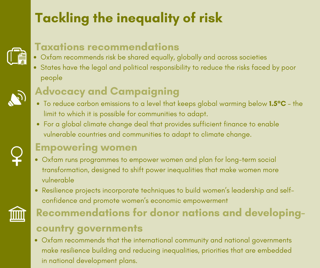
Inequality exposes poor people to risk more than the wealthy, and poor people are less able to cope with risk. In countries that are more unequal, it is harder for people to pull themselves out of poverty.
Taxation
Oxfam recommends that risk should be shared more equally, globally and across societies. States have the legal and political responsibility to reduce the risks faced by poor people, and ensure that they are borne more evenly across society.
Poor people need greater access to decision-making and to be better protected through greater access to services like social protection and health paid for by more progressive taxes. This includes setting up and funding truly effective systems that tackle underlying drivers of risk and vulnerability, and putting in place systems to prepare for and respond to disasters; providing livelihood options so that people can earn a living wage; ensuring equal access to services and to political participation in society, and sharing risk through social insurance.
All of this costs money, and governments, supported as necessary by donors, must use progressive tax systems and other means, including reducing corruption, to effectively redistribute risk in their societies.
Campaigning
Campaigning is an essential part of Oxfam’s work. Oxfam is challenging world leaders to take more ambitious action against climate change.
Oxfam is campaigning for a global climate change deals that:
-
Reduces carbon emissions
-
Provides sufficient finance to enable vulnerable countries and communities to adapt to climate change.
All of these campaigns work to empower vulnerable communities and further enable them to become resilient.
Advocacy
Without the skills to negotiate and the ability to influence decision-making, vulnerable farmers may be unable to demand the investments they need, and will remain marginalised.
Empowering Women
At the heart of Oxfam’s approach lies an understanding that reducing vulnerability requires more than technical solutions; it calls for a redistribution of power and a commitment to tackling the many forms of inequality that are on the rise.
Women and girls, with their varied roles as food producers and providers, care-givers, and economic actors, are most likely to be affected by disasters, climate change and food price shocks. The impacts of shocks have repercussions at the household level, which often exacerbate women’s vulnerability.
Investments in resilience will not ‘trickle down’ to women if they do not address deep-rooted gender inequality and the disproportionate burden placed on the shoulders of women living in poverty.
Oxfam has carried out research to ensure that our resilience programmes empower women. Programmes plan for long-term social transformation, designed to shift power inequalities that make women more vulnerable. Resilience projects incorporate techniques to build women’s leadership and self-confidence and promote women’s economic empowerment.
Recommendations for donor nations and developing-country governments
Current funding for climate change adaptation is too small. Major investments in vulnerable farmers are needed to reverse trends and ensure that farmers are not only just able to cope with the shocks and stresses of climate change, but also have the tools to build their resilience and have choices about how to live their lives and make plans.
Oxfam recommends that the international community and national governments make resilience building and reducing inequalities priorities that are embedded in national development plans.
What does Oxfam do to help support farms build resilience to climate change?
Oxfam is working to strengthen livelihoods of those most vulnerable in each community to improve their resilience to disaster. Improving people’s resilience to natural disaster means that they are less likely to be subjected to increased vulnerabilities.
Oxfam is working with communities to avoid them slipping into an emergency when climate change affects their livelihoods. Instead Oxfam helps farmers to adapt their practices to cope with the impacts of climate change. This enables them to produce enough food to feed their families each year, and to flourish even in uncertain climate conditions.
As well as supporting specific communities to become resilient in the face of climate change, Oxfam also works on many other levels to reduce risk and strengthen resilience. Vulnerable small-scale farmers are also affected by policy addressing both climate change mitigation and adaptation to climate change.
Inequality exposes poor people to risk more than the wealthy, and poor people have less ability to cope with risk. In countries that are more unequal, it is harder for people to pull themselves out of poverty.
Climate Resilience Field Schools in Mindanao, Philippines
Where is Mindanao?
Mindanao is the largest and most southern island of over seven thousand that make up the Philippines. Smallholder farmers, those who do not own their land, make up the majority of the population in central Mindanao. Most farmers in the central provinces of Mindanao depend on growing a single crop to sell for income to support their families (usually rice).
What are the issues relating to climate and farming?
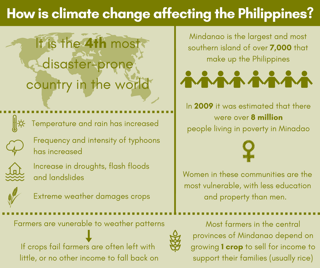
According to the United Nations Office for Disaster Risk Reduction, the Philippines is the fourth most disaster-prone country in the world, according to a report on the human cost of weather related disaster. Climate change is contributing to an increase in the frequency and intensity of Typhoons as well as a general rise in temperatures and rain, which leads to an increase in droughts, flash floods and landslides - all of which damages crops. For example, in 2012 Typhoon Pablo killed over 1000 people and it is estimated that around £186m worth of banana crops were lost. The Philippines is the world’s third largest exporter of the crop (BBC, 2012).
Damaged crops as a result of natural disasters often mean that farming families do not have the means to make a decent livelihood and are pushed into poverty. As farmers usually depend on a single crop, they are extremely vulnerable to any changes in weather patterns - when their crop fails they have nothing left to fall back on and are left with no other source of income to get them through the year.
Since 2006 studies show that overall poverty in Mindanao has steadily increased and in 2009 it was estimated that there were over eight million people living in poverty. Women in these communities are the most vulnerable, often owning very little property and poorly educated, which means they usually have very little say in decisions that affect them.
The fact that most poor farmers in the central provinces of Mindanao don’t own their own land makes their ability to survive through changing weather conditions more difficult. Landowners dictate not only what farmers are able to grow but also how they grow it, leaving the farmers with very little influence over their own livelihoods.
What are Climate Resiliency Field Schools?
Oxfam has set up a number of Climate Resiliency Field Schools in Mindanao, where farmers, who have been identified as leaders in their community, are asked to attend seminars learning about climate change, new farming practices, technologies and crop diversification. The schools helps communities formulate strategies and plans to cope with and adapt to climate change.
Each field school has around 32 members. Each group of students attends six sessions over a three-month period where they cultivate new crops and make and use their own organic fertilizer on a communal field. This gives farmers the opportunity to try new crops and farming techniques without taking on a financial risk. The idea is that farmers can then take this experience and apply it to their own land, eventually leading to them being more financially secure and therefore resilient to changes in weather that may affect some of their crops.
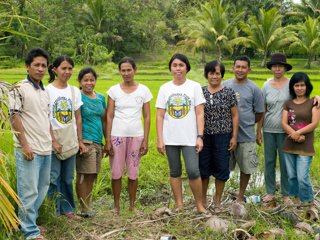

Climate Resiliency Field School Members, © Tessa Bunney, Oxfam
 The farming schools support communities to understand the risks from climate change and other factors that can affect the lives of smallholder farmers. With this knowledge, communities are more able to bounce back when they are affected by unexpected changes to the weather. With the training from Oxfam, even when livelihoods are affected by climate change, economic growth is still possible as farmers find new ways to generate an income.
The farming schools support communities to understand the risks from climate change and other factors that can affect the lives of smallholder farmers. With this knowledge, communities are more able to bounce back when they are affected by unexpected changes to the weather. With the training from Oxfam, even when livelihoods are affected by climate change, economic growth is still possible as farmers find new ways to generate an income.
Each community that Oxfam is working with formulates its own ‘Adaptation and Risk Reduction Plan’ specific to their particular needs.

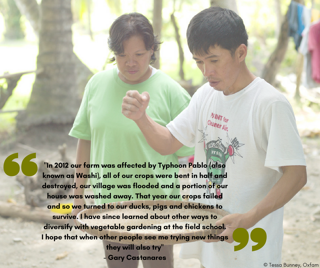
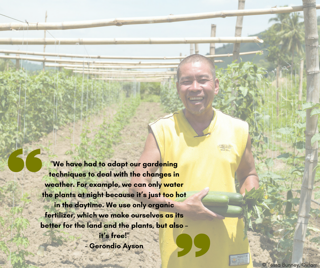

Climate Resiliency Field School - Emily Alpass demonstrates how to weed an organic paddy field ©Tessa Bunny, Oxfam.
 Lesson Plans
Lesson Plans
Using the people profiles (see Downloads) pupils should produce a storyboard to represent ONE of these profiles. It should work to illustrate how that person has been assisted by the Oxfam farming school and how their resilience has developed.
Take a look at Gary’s story; starting with the phrase ‘the Philippines is the 4th most disaster prone country in the world’ and ending with ‘I have since learned other ways to diversify at the field school’ pupils should plot a flow diagram that highlights how climate change impacts Minadao. This should encourage students to engage and link the global scale to local changes.
As a class, discuss the idea of ‘resilience’, and what pupils understand it to mean. Can pupils think of examples? Plot these together and think about ways organisations such as Oxfam can help international development.
Key Words
Advocacy
Public support for or recommendation of a particular cause or policy.
Climate change
A change in global or regional climate patterns, in particular a change apparent from the mid to late 20th century onwards and attributed largely to the increased levels of atmospheric carbon dioxide produced by the use of fossil fuels.
Resilience
The capacity to recover quickly from difficulties; and improve on previous conditions.
Small scale farming
Farming on small plots of land, usually by individual or family farmers, often for home consumption and without using major external inputs such as fertiliser and farm equipment. By contrast, commercial farming is often on large plantations where single crops are grown for export or processing.
Links
Oxfam International (2013) No Accident: Resilience and the inequality of risk
Oxfam International (2009) 135 Oxfam Briefing Paper: People Centred Resilience: Working with vulnerable farmers towards climate change adaptation and food security
Oxfam Canada (2014) Resilience in times of food insecurity: Reflecting on the experiences of women’s organizations
Oxfam International (2013) No Accident: Resilience and the inequality of risk
Oxfam UK (2016) What issues to do we work on?
Philippines among world's most disaster-prone countries (2016) CNN
Rutter, S (2016) Resilience to what? Resilience to whom? The Geographical Journal 182 (2) 109-224
The Global Risks Report (2017)
The human cost of weather related disaster (2015) United Nations Office for Disaster Risk Reduction
Five reasons the Philippines is so disaster prone (2013) National Geographic
Typhoon Bopha hits Philippine banana crop (2012) BBC:
Resources
Climate Challenge for 11-14 years – Explore the human impact of climate change




